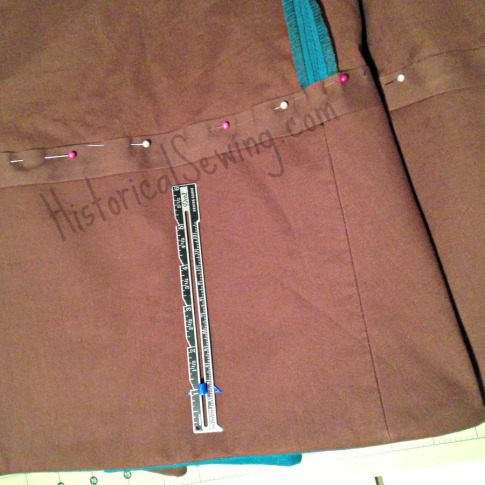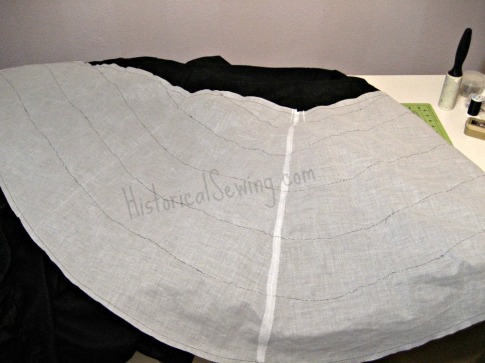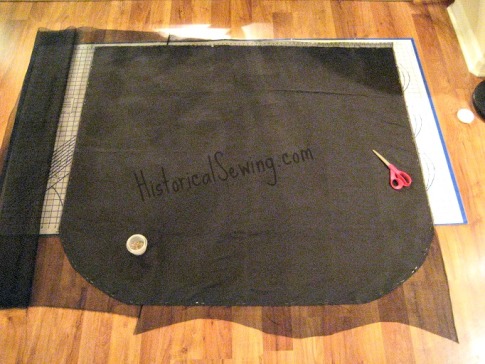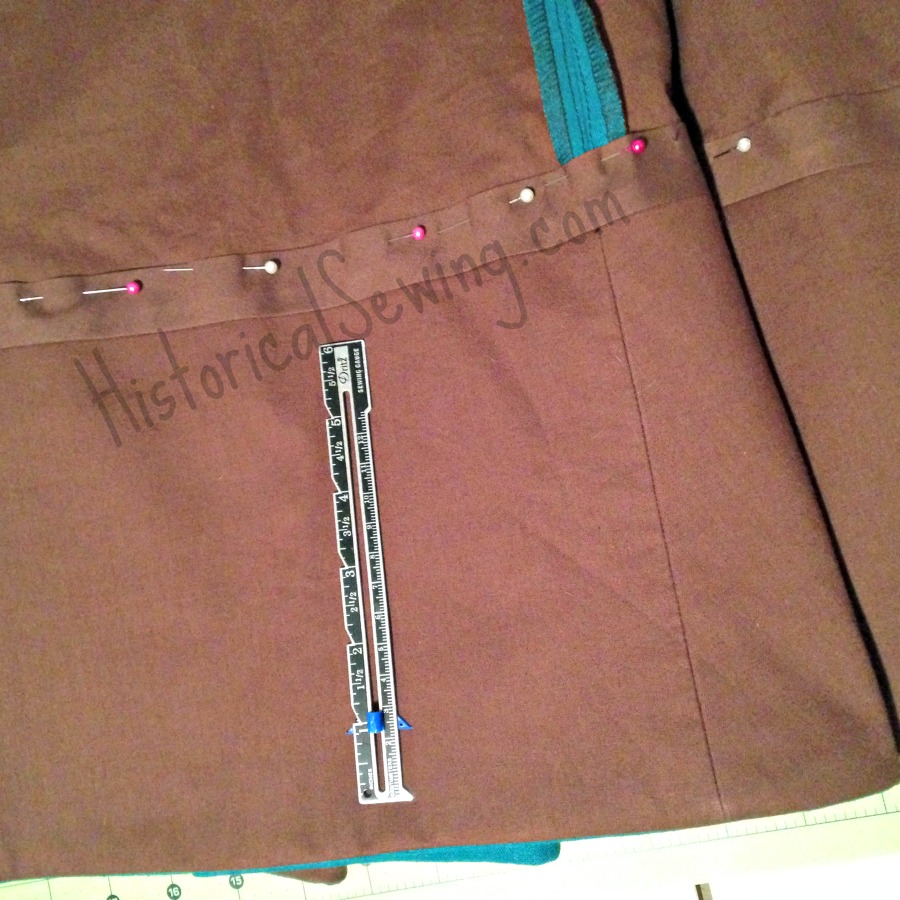
The importance of flatlining skirts cannot be understated. Although, there is a time and place for using underlinings or a lining or both. Or even leaving off linings altogether and simply relying on hem facings and petticoats to keep the silhouette in place.
To follow up my post on how to flatline bodices, let’s go over tips & tricks for flatlining skirts of the 1800s. (Read up on flatlining sleeves as well.)
A lot of the commercial patterns out there for Victorian costumes won’t even discuss the process of using an underlining with a skirt let alone mention it. They rely on using separate linings or just assume the dressmaker knows what they’re doing.
But to make a 19th century skirt consists of a little more than just sew the side seams, turn up the hem and stitch, and slap on a waistband.
The basis of underlining is to support your fashion fabric in the hand of the fabric, layers of trim, and the fashionable silhouette.
Sometimes your fashion fabric is sturdy enough on its own to not need an extra layer of support. But if you intend to make a tailored skirt or one with lots of trims mounted to it, you’ll be happier by backing the fashion fabric with an underlining.

How to Flatline Skirt Panels
The process to add an underlining to your skirt is fairly straightforward. To flatline you cut both the fashion fabric and the underlining fabric from the skirt panel pieces. Then you lay each matching panel together, wrong sides together and baste around the edges.
When flatlining skirt panels I recommend only basting the long, vertical edges and leave the waistband and hem edges open. After seaming, those edges can be basted together if needed.
You’ll want to follow the grain when basting the layers together. For skirt panels this generally means from hem up to waist – from the widest part of the piece to the narrowest.
Keep your basting stitches slightly within the seam line, too, for easy removal or to prevent them from showing on the right side of the garment. At this point it’s super easy to finish the raw edges with either serging or pinking. Or do a hand whipstitch after the seams are sewn.
After flatlining, give the edges a quick press before continuing.
From here on, in the construction you treat each double layer as one piece. Sew up the seams, mount trims and finish with hem and waistband. Yes, the edges will be exposed on the inside. This is period correct to leave as is or add a full lining.
Fabrics for Skirt Underlinings
Good fabric options to mount to the back of your skirt fashion fabric vary (don’t they all!). It really depends on your fashion fabric – how tightly woven it is, the weight, if it’s thin or heavy.
Generally for skirts you can use plain cotton muslin or calico, lightweight twill, poplin, cotton organdy or silk organza. These are my favorites. Linen can be used but make sure to pre-wash once or twice for maximum shrinkage before cutting. You want fabrics that won’t stretch out over time.
I’ve learned over the years that our modern fabrics are simply much heavier than our Victorian ancestors’. So be cautious when selecting an underlining fabric. Play with samples of that silk or wool fashion fabric to see what lays great behind it. That twill may seem like a good choice under a quilting cotton, but it may risk making the skirt awfully heavy and bulky.
Sometimes less is more. You might be surprised at how a thin cotton organdy can give so much body and structure to a skirt. Keep your mind on lighter fabrics rather than heavy materials.

When You Can Skip the Underlining
Yes, there are times you can get away without flatlining your skirt.
Generally, you can leave off the underlining IF you have two or more petticoats that can support your skirt and the silhouette. Petticoats (of which, I widely promote the wearing of) not only help produce the historical silhouette you want but keep the skirts in place. Kind of a backwards idea but it’s true.
Another time to leave off the underlining backing is for sheer dresses. That’s the point of sheers – to keep them light and airy. With these you MUST wear multiple petticoats for support.
If you don’t want to flatline, most often you’ll want to put in a deep hem facing to support the hem and shaping. Keep those petticoats on too!
Specific 19th Century Eras to Flatline Skirts
Regency – no need for flatlining skirts. Although, some bodices will do well with it; the skirts don’t need it. Use petticoats to support the slender silhouette.
1820s & 1830s, Romantic Era – Coming off the slim look of the Regency most skirts, even those cut from light cotton prints, don’t need a full underlining. This is one reason deep hem facings started to be applied. Think of a hem facing as a short underlining fabric mounted just around the hem area.
These Romantic ancestors needed to keep the skirt flare but didn’t want to weigh it down with linings. Petticoats and hem facings… your friends in this fun era. However, if you have heavy rouleux or applied trims so popular in this time, you may want to consider fully flatlining each panel.
1840s to 1860s, Early & Mid-Victorian Era – Skirts of these decades tend to be flatlined with basic polished cotton. Early years were coming off the deep hem facing period and you’ll find originals with both a full underlining and deep facing. Again, it’s all to support the silhouette and fashion fabric. Keep overskirts and wide ruffles light with no underlining but mount on top of a fully flatlined skirt base.
1870s & 1880s, Bustle Era – Yes. Flatline those panels but keep the underlining fabrics lighter than you think. Skirts draped over wire bustle shapes will hang much better when flatlined.
Overskirts are beautiful when backed by organdy or silk organza. It gives them a little bit of body but keeps them light. Not all overskirts need the extra support. Although, some bustle dress designs are rather intricate and will need the structure underlinings give. Play with your fabrics keeping your design in mind.
When making sheer bustle dresses you can get away with the skirts not mounted to anything – keep those petticoats around though! Or merely flatline the foundation skirt, if you need it, keeping the overskirt in just the one fashion fabric layer.
1890s, Late Victorian – These skirts can definitely use the structure underlining provides. Although, some heavy fabrics like wools and twills only require hem facings. Remember that each layer you add to the skirt the heavier it becomes. Did I mention how petticoats are your friend? 🙂

A Tip to Reduce Your Fashion Fabric Yardage Requirement
Now here’s a cheater method that is actually historical correct. In some designs, especially layered looks like in the Bustle Era years, you can cheat on your skirt panels by cutting your expensive fashion fabric short but using a full panel of underlining fabric.
Cut your main skirt panels out of a sturdy twill, poplin or polished cotton. Then, flatline your delicate fashion fabric ON TOP of it at only the sections that will be seen.
You’ll often times see original underskirts with their tan polished cotton underlining visible and the silk mounted to just the hem sections. The overskirt covers the top portion of the cotton so why waste the silk fabric on that area?
The above picture is a skirt side panel with a sheer striped fashion fabric pinned to the top section of the full-cut underlining fabric panel. The white cotton underlining will be covered with ruffles around the hem. – No need to waste fashion fabric when it’ll be covered!
So next time you’re sewing Victorian skirts, consider flatlining each panel to give support to the trims and help produce that wonderful period silhouette you’re shooting for. You’d be surprised at the difference it makes for construction and also the final look of the garment.
Do you flatline your skirts? Have you missed this essential sewing construction step before then realized it later just how valuable it is? Have you made a skirt too heavy by flatlining? (I’m still learning this one…)


I have a silk charmeuse fabric for an 1850s dress, what would you recommend? I already bought a simple cotton fabric, but I think I may need to get something lighter. Would you recommend silk organza for this project? I found a nice one online but would love some advice.
Yes, definitely silk organza. Maybe even two layers if the charmeuse needs it.
Why would you leave the hem and waistband open when flatlining, and at what point would you baste them together? I’m making a dress now and have been wondering about how to deal with the fabric relaxing and sagging down under its own weight. Does your advice have anything to do with this?
Your writing is so incredibly helpful, thank you so much!
To clarify, you baste the underlining and skirt fabric together along the long vertical edges but don’t stitch/baste these layers along the waist and hem edges. Basting those edges can come later just before you finish the hem and/or waistband.
For sagging fabric you could let the fabric hang to naturally stretch it before cutting your pieces. Depends on your fabric type/weave/content and what you’re trying to make for how to flatline the skirt panels. If the fashion fabric is very heavy, it may not be a good choice for the skirt style you are attempting.
Hello, if I am cartridge pleating an 1860s skirt (a piece of lightweight fabric, 6 metres long) would I need to flatline it, and how would I do it? I am making this for my own prom dress, and it gets quite hot here in the summer. Thank you!
You don’t need to flatline the skirt. I would recommend, however, a deep hem facing (see this post), and fold down a good amount at the top to support the pleats. Check out my post here on cartridge pleating. For silhouette support – use petticoats! 🙂
I am about to embark on another 1840s dress (Laughing Moon 114 Round Dresses) in a Moda quilting cotton. There will be petticoats. I always flatline the bodice, but should I flatline the skirt as well to reduce wrinkles? Muslin? Light Organdy? Or not…?
Many skirts in this era are not fully flatlined. Winter wear they might be. I would recommend a deep hem facing; it’s historically appropriate from the era and will help hang the skirt properly over your petticoat layers. (So glad to hear you’re wearing them!) Basic cotton or organdy are both good options. Play with layers of both fashion and hem facing fabrics to see how the they behave together. Good luck!